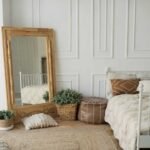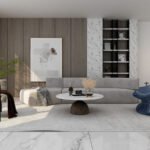Scandinavian Aesthetic interior design started in the early 20th century. It combines the styles of Denmark, Sweden, Iceland, Finland, and Norway. This design became popular in North America in the 1950s, thanks to the Bauhaus movement and industrialization.
It focuses on simplicity, functionality, and making life better through design. This design aims to make our daily lives easier and more enjoyable.
Scandinavian design is all about minimalism, quality, and using natural elements. It also includes neutral colors with a few bold ones. The idea of hygge, or cozy togetherness, is at its heart. By following these principles, you can make your home feel calm, bright, and welcoming.
Key Takeaways
- Scandinavian design emphasizes simplicity, functionality, and accessibility, aiming to improve daily life through thoughtful design.
- Key principles include minimalism, quality craftsmanship, natural elements, neutral color schemes with pops of color, and the concept of hygge (cozy togetherness).
- Scandinavian design gained popularity in North America during the 1950s, influenced by the Bauhaus movement and the region’s focus on industrialization.
- Incorporating natural light, neutral palettes, and decluttering are essential for achieving the Scandinavian aesthetic in your home.
- Scandinavian design has evolved over the years, now incorporating bolder colors and fusion with other design styles while maintaining its core principles.
Understanding the Origins of Scandinavian Design
The Scandinavian design movement started in the early 20th century. It mixed traditional Nordic craftsmanship with modern, minimalist looks. This style, born in Scandinavian countries, has won hearts around the world, changing many homes and interiors.
The Birth of Nordic Design Movement
Scandinavian design began in the mid-20th century. It was shaped by the history and culture of the Nordic countries. The Art Nouveau movement, from 1880 to 1910, was the start of Modernism, inspired by nature.
This organic style was the base for Scandinavian design principles that followed.
Influence of Mid-Century Modern
The Scandinavian design movement met mid-century modern design. Both focused on simplicity, function, and being easy to use. They were influenced by industrialization and the Bauhaus movement, which valued clean lines and natural materials.
Core Design Principles from Scandinavian Countries
Scandinavian design is all about minimalism, function, and nature. It’s called “democratic design” because it aims to make beautiful, useful, and affordable items for everyone. Exhibitions helped spread this design, influencing modernism in North America and Europe.
| Key Characteristics of Scandinavian Design | Examples |
|---|---|
| Minimalism and Functionality | Furniture, home decor, and lighting solutions designed for optimal utility and clean, simplified forms |
| Sustainability and Craftsmanship | Focus on durable, high-quality materials and timeless design for long-term use |
| Connection to Nature | Incorporation of natural elements, such as wood, stone, and natural light, into architectural and interior design |
| Accessible and Affordable Design | Mass-produced, well-designed products that are within reach of the average consumer |
“Scandinavian design is often referred to as ‘democratic design,’ as it aims to create beautiful, practical, and affordable products that appeal to the masses.”
Essential Elements of the Scandinavian Aesthetic

The Scandinavian design is known for its timeless beauty, minimalism, and love for nature. It started in the 1930s and has won hearts worldwide. It combines function, simplicity, and elegance in a unique way.
Minimalism: Scandinavian design loves minimalism. It uses clean lines and simple shapes. This makes spaces calm and lets materials speak for themselves.
Natural Materials: It celebrates natural materials like wood, wool, and rattan. These add warmth and texture, connecting us to nature.
Neutral Color Palette: Scandinavian interiors often use white, beige, and gray. This color scheme is calm and lets materials shine.
Hygge and Coziness: The idea of hygge is key in Scandinavian design. It’s about cozy, inviting spaces. Textiles, fireplaces, and lighting make these spaces warm and welcoming.
Scandinavian design aims to make spaces beautiful and useful. It reflects the region’s love for nature and simplicity.
Mastering Natural Light and Color Palettes

Scandinavian design focuses on using natural light and soft colors. This creates a calm and balanced look. Homeowners can bring this style into their homes by using daylight and neutral colors.
Maximizing Natural Light Sources
Scandinavian design loves natural light. It uses big windows to let in lots of daylight. This makes rooms feel open and bright. Mirrors can also make spaces look bigger and brighter.
Working with Neutral Color Schemes
Neutral colors like whites, creams, and grays are key in Scandinavian design. These colors reflect light and make spaces feel calm. Walls in these colors provide a clean background for natural materials and textures.
Strategic Use of Accent Colors
Even though neutrals are main, accent colors add interest. Blues and greens in muted shades are popular. They add a touch of color without disrupting the calm. Bright colors can be used in accessories or textiles, but keep it simple.
“The Scandinavian design philosophy is all about creating a sense of calm, minimalism, and functionality in the home.”
Minimalism and Decluttering the Nordic Way
Scandinavian design is all about minimalism and decluttering. But it does so with a balanced approach. This is guided by the Swedish concept of “lagom,” which means just the right amount. It’s like Marie Kondo’s “just-right click point,” aiming for a clean look without losing comfort and personality.
The Scandinavian way of minimalism means being mindful of what you buy. It’s about choosing items that serve more than one purpose. This helps create a sense of openness. It also helps counteract the long, dark winters by letting in more natural light.
By focusing on simplicity, Nordic homes become more intentional and sustainable. This approach reduces unnecessary waste. It encourages living in a way that’s better for the planet.
Scandinavian minimalism finds a middle ground, avoiding too much or too little. It uses natural materials like wood, wool, and leather to add warmth. Neutral colors and the right accent colors help create a clean, unified look. This is what makes Nordic design so special.
Also Read : Step – By- Step Guide To Adopting A Minimalist Design In Your Home
FAQs
Q: What are the main characteristics of Scandinavian interior design?
A: The main characteristics of Scandinavian interior design include a minimalist aesthetic, functional furniture, a focus on natural materials, and a neutral color palette. Elements such as wood, light tones, and cozy textiles are commonly used to create a warm and inviting atmosphere.
Q: How does the history of Scandinavian design influence modern decor?
A: The history of Scandinavian design, which emphasizes simplicity, functionality, and craftsmanship, continues to influence modern decor. Many Scandinavian designers draw inspiration from these historical principles to create contemporary pieces that balance aesthetics with practicality.
Q: What role do colors play in Scandinavian home decor?
A: Scandinavian colors typically include soft, muted tones like whites, grays, and pastels. These colors help to create a bright and airy environment, reflecting the natural light prevalent in Nordic countries. Accent colors can be added through decor items to introduce warmth and personality.
Q: Can you explain the concept of hygge in Scandinavian interior design?
A: Hygge is a Danish concept that emphasizes coziness and comfort. In Scandinavian interior design, this is achieved through the use of soft textiles, warm lighting, and inviting furniture arrangements. The goal is to create a welcoming space that promotes relaxation and well-being.
Q: What are some essential elements of Scandinavian design?
A: Essential elements of Scandinavian design include functional furniture, minimalist forms, natural materials like wood and wool, and a focus on light and space. These elements work together to create a harmonious and tranquil living environment.
Q: How can I incorporate Scandinavian minimalism into my home?
A: To incorporate Scandinavian minimalism into your home, focus on decluttering your space and selecting furniture that is functional yet stylish. Choose a few key decor pieces that reflect the Scandinavian style, such as simple rugs, neutral colors, and natural materials, to enhance your interior design.
Q: What types of furniture are typical in a Scandinavian home?
A: Typical Scandinavian furniture includes pieces that are functional, simple, and made from natural materials. Brands like IKEA exemplify this style with their clean lines and practical designs. Look for items like light-colored wood tables, comfortable sofas, and minimalist chairs to achieve an authentic Scandinavian look.
Q: How does texture impact the aesthetics of Scandinavian interior design?
A: Texture plays a crucial role in Scandinavian interior design by adding depth and warmth to minimalist spaces. Combining various textures, such as soft rugs, knitted throws, and wooden surfaces, can create a cozy atmosphere while maintaining the clean lines and simplicity characteristic of the style.
Q: What is the significance of natural materials in Scandinavian decor?
A: Natural materials are significant in Scandinavian decor because they connect the interior to the beauty of the outdoors. Wood, wool, and stone are commonly used to create a warm and inviting atmosphere, reflecting the region’s natural landscape and promoting sustainability in design.
Source Links
- https://www.architecturaldigest.com/story/scandinavian-interior-design-style-explainer
- https://www.moderndane.com/blogs/the-modern-dane-blog/scandinavian-interior-design-6-tips-to-bring-scandi-style-to-your-home?srsltid=AfmBOorYpuHXwG8sKIm4-KVhoZbMfQlPeqoyXBIQkhA_TcZmgZqWZEK9
- https://www.smashingmagazine.com/2011/06/the-story-of-scandinavian-design-combining-function-and-aesthetics/





